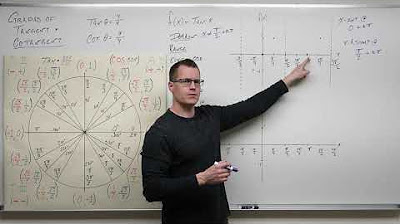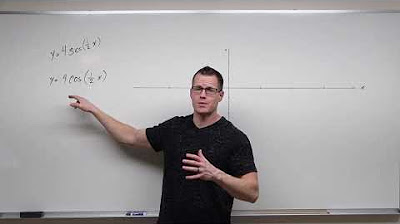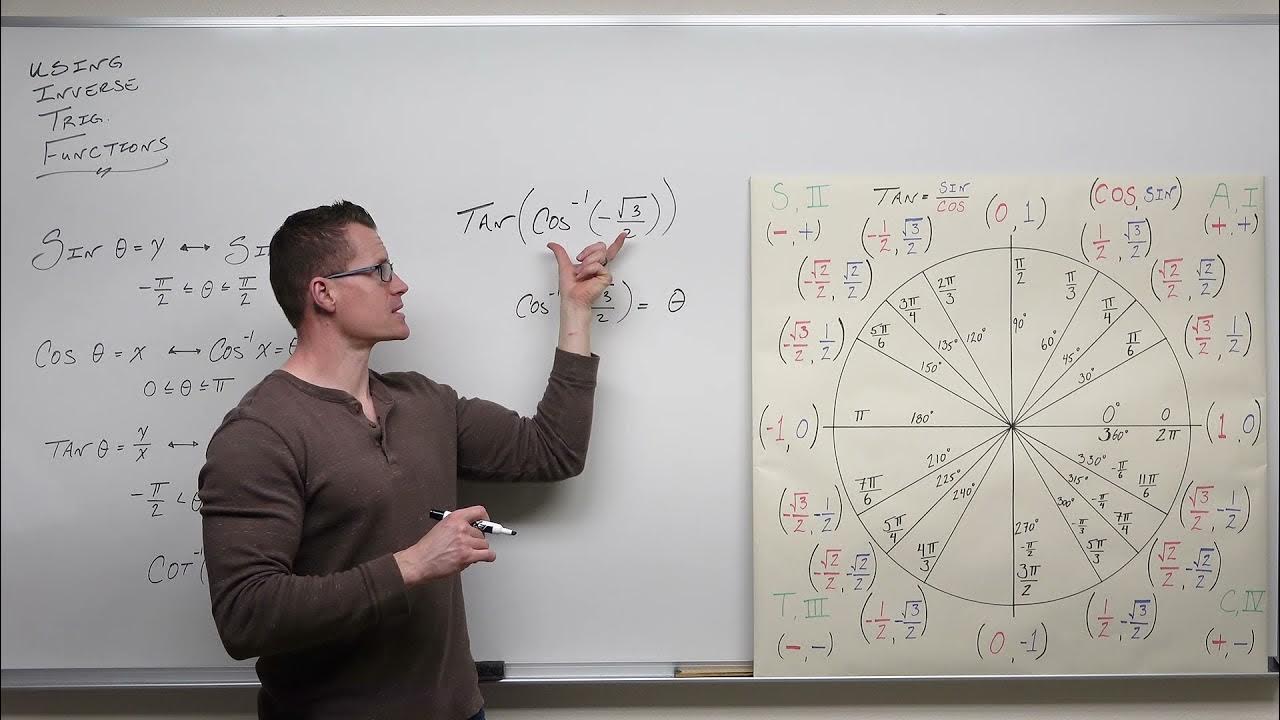Trig - 0.3 Domains of Trigonometric Functions
TLDRThis video script delves into the domains of the six trigonometric functions, emphasizing their importance in calculus. It explains that sine and cosine have unrestricted domains, meaning they are defined for all real numbers. In contrast, tangent and secant have asymptotes, leading to discontinuities at odd multiples of pi/2. The script also covers cotangent and cosecant, which have asymptotes at multiples of pi. The video uses the unit circle to illustrate these concepts, making it easier to understand where each function is defined and where they are not. The presentation is designed to clarify the fundamental aspects of trigonometric functions, preparing viewers for more advanced mathematical concepts.
Takeaways
- 📐 The domain of sine and cosine functions is all real numbers, as they are defined for every point on the unit circle.
- 🚫 Tangent and secant functions have restricted domains due to asymptotes, which occur at odd multiples of pi/2.
- 🔢 The tangent function is undefined where the cosine function equals zero, which happens at pi/2, 3pi/2, 5pi/2, etc.
- 🔄 Secant's asymptotes are located at pi*n/2, where n is an odd integer, leading to discontinuities in its graph.
- 🎚️ Cotangent is the reciprocal of tangent, thus its domain excludes where the sine function equals zero, at multiples of pi.
- 🚷 Cosecant also has a domain that excludes multiples of pi, as it is the reciprocal of the sine function.
- 🔁 The pattern of asymptotes for both tangent and secant repeats every pi, showing a periodicity in their undefined points.
- 📈 The unit circle is a helpful tool for visualizing the domains and ranges of trigonometric functions, especially sine and cosine.
- ↔️ The relationship between the coordinates of the unit circle (cosine, sine) and the definitions of tangent and cotangent is crucial for understanding their domains.
- 📉 The cosecant function's domain excludes all points where the sine function is zero to avoid division by zero errors.
- 🧮 Set builder notation is used to formally express the domains of the trigonometric functions, specifying the values for which they are defined.
Q & A
What are the six trigonometric functions mentioned in the video?
-The six trigonometric functions mentioned are sine, cosine, tangent, secant, cotangent, and cosecant.
What is the domain of the sine and cosine functions?
-The domain of the sine and cosine functions is all real numbers, as there are no restrictions on their values.
How are the coordinates of the unit circle related to the sine and cosine functions?
-The coordinates of the unit circle are represented as (cosine of theta, sine of theta), which shows that every point on the unit circle corresponds to a defined value for both sine and cosine functions.
Why are the tangent and secant functions not defined everywhere?
-The tangent and secant functions are not defined everywhere because they have asymptotes, which are areas of discontinuity, directly related to their definitions as ratios of sine to cosine and cosine to sine, respectively.
At what values of theta does the tangent function become undefined?
-The tangent function becomes undefined when the cosine of theta is zero, which occurs at odd multiples of pi over 2 (e.g., pi/2, 3pi/2, 5pi/2, etc.).
How are the asymptotes of the secant function related to the values of theta?
-The asymptotes of the secant function occur at odd multiples of pi over 2 (e.g., pi/2, 3pi/2, 5pi/2, etc.), which are the same points where the tangent function is undefined.
What is the relationship between the cotangent and tangent functions?
-The cotangent function is the reciprocal of the tangent function, meaning it is defined as cosine over sine, whereas the tangent is sine over cosine.
At what values of theta does the cotangent function become undefined?
-The cotangent function becomes undefined when the sine of theta is zero, which occurs at all integer multiples of pi.
What is the domain of the cotangent and cosecant functions?
-The domain of the cotangent and cosecant functions excludes all integer multiples of pi, as these are the points where they are undefined due to their denominators being zero.
How can the domain restrictions for tangent and secant be expressed in set builder notation?
-The domain restrictions for tangent and secant can be expressed as all x's such that x is not equal to (2n + 1)π/2 for all integer values of n.
How can the domain restrictions for cotangent and cosecant be expressed in set builder notation?
-The domain restrictions for cotangent and cosecant can be expressed as all x's such that x is not equal to nπ for all integer values of n.
What topic is discussed next in the video after the domains of trigonometric functions?
-The next topic discussed in the video is the fundamental trigonometric identities.
Outlines
📚 Understanding Trigonometric Functions' Domains
This paragraph introduces the topic of the video, which is the exploration of the domains of trigonometric functions. It emphasizes the importance of understanding these domains, particularly for their frequent appearance in calculus. The video covers all six trigonometric functions (sine, cosine, tangent, cotangent, secant, and cosecant) in relation to the unit circle. Sine and cosine are noted to have no restrictions on their domain, meaning they are defined for all real numbers. In contrast, tangent and secant have asymptotes and are undefined at certain points, which are odd multiples of pi/2. Cotangent and cosecant also have restrictions, being undefined at multiples of pi. The paragraph concludes with a teaser for the next topic: fundamental trigonometric identities.
Mindmap
Keywords
💡Trigonometric functions
💡Unit circle
💡Domain
💡Asymptotes
💡Sine function
💡Cosine function
💡Tangent function
💡Secant function
💡Cotangent function
💡Cosecant function
💡Set builder notation
Highlights
The video discusses the domains of trigonometric functions, emphasizing their importance in calculus.
All six trigonometric functions are examined in relation to the unit circle for better understanding.
Sine and cosine have no restrictions on their domain, as demonstrated by the defined values on the unit circle.
The coordinates of the unit circle are given by (cosine of x, sine of x), highlighting that all values are defined.
Tangent and secant functions have areas of discontinuity and are not defined everywhere due to their respective asymptotes.
Tangent is defined as sine theta over cosine of theta, leading to undefined values when the cosine is zero.
Secant is the reciprocal of the tangent, defined as cosine over sine, and also has discontinuities where sine is zero.
The video identifies specific values of theta where the tangent and secant functions are undefined, such as pi/2 and 3pi/2.
Cotangent and cosecant functions are also examined, with their domains excluding certain multiples of pi.
The domain of sine and cosine is all real numbers, with no restrictions.
The domain of tangent and secant excludes odd multiples of pi/2, expressed in set builder notation.
The domain of cotangent and cosecant excludes all multiples of pi, again using set builder notation.
The video provides a comprehensive summary of the domains of trigonometric functions, which is crucial for further studies in calculus.
The unit circle serves as a visual tool to understand the domains of trigonometric functions and their relationship with angles.
Understanding the domains of trig functions is essential for solving calculus problems and comprehending the behavior of these functions.
The video's approach to explaining trigonometric domains is both practical and theoretical, offering insights into their applications in calculus.
The domains of trigonometric functions are foundational knowledge that students must grasp to progress in mathematical studies, especially in calculus.
Transcripts
Browse More Related Video

Trig Visualized: One Diagram to Rule them All (six trig functions in one diagram)

The Ranges of Trigonometric Functions

How to Graph Tangent and Cotangent (Precalculus - Trigonometry 13)

Even and Odd Trigonometric Functions & Identities - Evaluating Sine, Cosine, & Tangent

How to Graph Cosecant and Secant (Precalculus - Trigonometry 15)

An Indepth Look at Using Inverse Trig Functions (Precalculus - Trigonometry 21)
5.0 / 5 (0 votes)
Thanks for rating: